
Distributed Programming
Lecture 05 - Multiplayer and Network
Communication in Unreal Engine
Edirlei Soares de Lima
<edirlei.lima@universidadeeuropeia.pt>

Multiplayer in Unreal Engine
•
The Unreal Engine is built with multiplayer gaming in mind.
–
Is very easy to extend a single player experience to multiplayer.
–
Even single-player games, use the networking architecture.
•
•
The engine is based on a client-server model.
–
The server is authoritative and makes sure all connected clients are
continually updated.
Actors are the main element that the server uses to keep
clients up to date.
–
The server sends information about the actors to clients;
–
Clients have an approximation of each actor and the server maintains
the authoritative version.

Multiplayer in Unreal Engine
•
The server is in charge of driving the flow of gameplay.
•
It handles network connections,
notifies clients when gameplay
starts and ends, when is time to
travel to a new map, along with
actor replication updates.
•
Only the server contains a valid
copy of the GameMode actor.
Clients contain only an approximate
copy of the actors, and can use it as
a reference to know the general
state of the game.

Multiplayer in Unreal Engine
•
Network Modes:
–
Standalone: the server runs on a local machine and not accept clients
from remote machines. Is used for single-player games.
–
Dedicated Server: the server has no local players and can run more
efficiently by discarding sound, graphics, user input, and other player-
oriented features. Is used for multiplayer games hosted on a trusted
and reliable server where high-performing are needed.
–
–
ListenServer: is a server that hosts a local player, but is open to
connections from remote players as well. Is good for games where users
can set up and play their own games without a third-party server.
Client: the machine is a client that can connect to a dedicated or listen
server, and therefore will not run server-side logic.

Multiplayer in Unreal Engine
•
The core element of the networking process in Unreal Engine
is Actor Replication.
–
The server maintains a list of actors and updates the client periodically
so that the client can have a close approximation of each actor (that is
marked to be replicated).
•
•
Actors are updated in two main ways:
–
Property updates;
–
RPCs (Remote Procedure Calls).
Properties are replicated automatically (any time they change)
and RPCs are only replicated when executed.

Property Replication
•
•
Example of property to be replicated: actor's health.
Each actor maintains a list of properties that can be marked
for replication to clients.
–
–
–
Whenever the value of the variable changes on the server side, the
server sends the client the updated value.
Property updates only come from the server (i.e.: the client will never
send property updates to the server).
Some properties replicate by default (e.g.: Location, Rotation, etc.).
•
Actor property replication is reliable.

Property Replication
•
Replicate a property:
1. Set the replicated keyword:
UPROPERTY(replicated)
float health;
2. Implement the GetLifetimeReplicatedProps function:
void MyClass::GetLifetimeReplicatedProps(TArray<FLifetimeProperty>&
OutLifetimeProps) const{
Super::GetLifetimeReplicatedProps(OutLifetimeProps);
DOREPLIFETIME(MyClass, health);
Default replication rule:
}
replicates to all clients
3. Enable replication in the constructor method:
SetReplicates(true);

Remote Procedure Calls (RPCs)
•
•
Example of RPC: a function to spawn an explosion to each
client at a certain location.
RPCs are functions that are called locally, but executed
remotely on another machine.
–
Primary use: to do unreliable gameplay events that are temporary or
cosmetic in nature.
–
E.g.: play sounds, spawn particles, or do other temporary effects that
are not crucial to the Actor functioning.
•
By default, RPCs are unreliable. To be reliable, a especial
keyword (Reliable) must be used in the definition of the RPC.

Remote Procedure Calls (RPCs)
•
Defining a RPC:
–
–
–
To declare a function as an RPC that will be called on the server, but
executed on the client:
UFUNCTION(Client)
void ClientRPCFunction();
To declare a function as an RPC that will be called on the client, but
executed on the server:
UFUNCTION(Server)
void ServerRPCFunction();
To declare a function as an RPC that will be called from the server, and
then executed on the server and on all connected clients:
UFUNCTION(NetMulticast)
void MulticastRPCFunction();

RPC Validation
•
•
The validation function for an RPC allows the detection of bad
parameters or cheating:
–
It can notify the system to disconnect the client who initiated the call.
Example:
UFUNCTION(Server, WithValidation)
void SomeRPCFunction(int32 AddHealth);
bool SomeRPCFunction_Validate(int32 AddHealth){
if (AddHealth > MAX_ADD_HEALTH){
return false;
}
return true;
}
void SomeRPCFunction_Implementation(int32 AddHealth){
Health += AddHealth;
}

Back to the First Game
•
•
Can we transform our first game into a multiplayer game?
–
Yes! We just need to fix some small issues.
Test the game in a multiplayer setup:
Two players

Back to the First Game
•
•
What works in multiplayer:
1
2
3
. Player movement;
. Zombie movement;
. Coins;
What doesn’t work in multiplayer?
1. No game mode in the client and no total number of collected coins;
2. End level area and the game over messages;
3. Enemy animation and walk speed;

Back to the First Game
•
•
First issue: there is no game mode in clients.
Solution:
–
–
–
–
Logic change: now multiple players can collect coins cooperatively, so its
more appropriate to show the number of remaining coins in the level;
Move the function that computes the number of coins in the level to
the character class (will be locally computed);
Change the blueprint that access the game mode to show the number
collected coins;

Back to the First Game
•
•
Second issue: end level area and the game over messages.
–
Problem 1: disable the player controller on all clients/server
• Issue: the CompleteLevel function runs only on the server, because it is implemented
in the Game Mode class.
Solution:
–
Create a multicast function in a Game State class;

Back to the First Game
•
•
Second issue: end level area and the game over messages.
–
Problem 1: disable the player controller on all clients/server
• Issue: the CompleteLevel function runs only on the server, because it is implemented
in the Game Mode class.
Solution:
–
Create a multicast function in a Game State class;
public:
UFUNCTION(NetMulticast, Reliable)
MyGameStateBase.h
void MulticastOnLevelComplete(APawn* character, bool succeeded);
void AMyGameStateBase::MulticastOnLevelComplete_Implementation(
APawn* character, bool succeeded){
for (FConstPawnIterator it = GetWorld()->GetPawnIterator(); it; it++){
APawn* pawn = it->Get();
if (pawn && pawn->IsLocallyControlled()){
pawn->DisableInput(nullptr);
}
MyGameStateBase.cpp
}

Back to the First Game
•
•
Second issue: end level area and the game over messages.
–
Problem 1: disable the player controller on all clients/server
• Issue: the CompleteLevel function runs only on the server, because it is implemented
in the Game Mode class.
Solution:
–
Set the new Game State class in the blueprint instance of the Game
Mode:

Back to the First Game
•
Second issue: end level area and the game over messages.
–
Problem 1: disable the player controller on all clients/server
• Issue: the CompleteLevel function runs only on the server, because it is implemented
in the Game Mode class.
•
Solution:
–
Call the multicast function in CompleteLevel function;
...
MyFirstGameGameMode.cpp
AMyGameStateBase *gameState = GetGameState<AMyGameStateBase>();
if (gameState)
{
gameState->MulticastOnLevelComplete(character, succeeded);
}
...

Back to the First Game
•
•
Second issue: end level area and the game over messages.
–
Problem 2: show the “Level Completed Message” for all clients/server.
• Issue: we need a class to create the widget that exist only once on the clients.
Solution:
–
Create the widget in a new Game Controller class;

Back to the First Game
•
•
Second issue: end level area and the game over messages.
–
Problem 2: show the “Level Completed Message” for all clients/server.
• Issue: we need a class to create the widget that exist only once on the clients.
Solution:
–
Expose the OnLevelCompleted to blueprint implementation:
MyPlayerController.h
public:
UFUNCTION(BlueprintImplementableEvent, Category = "Gameplay Events")
void OnLevelCompleted(APawn* charact, bool succeeded);
–
Create a blueprint for the new player controller and implement the event:

Back to the First Game
•
•
Second issue: end level area and the game over messages.
–
Problem 2: show the “Level Completed Message” for all clients/server.
• Issue: we need a class to create the widget that exist only once on the clients.
Solution:
–
Call the OnLevelCompleted function in the Multicast function:
void AMyGameStateBase::MulticastOnLevelComplete_Implementation(
APawn* character, bool succeeded){
...
for (FConstPlayerControllerIterator it =
GetWorld()->GetPlayerControllerIterator(); it; it++){
AMyPlayerController* pController = Cast<AMyPlayerController>
(it->Get());
if ((pController) && (pController->IsLocalController())){
pController->OnLevelCompleted(character, succeeded);
}
}
}
MyGameStateBase.cpp

Back to the First Game
•
•
Second issue: end level area and the game over messages.
–
Problem 2: show the “Level Completed Message” for all clients/server.
• Issue: we need a class to create the widget that exist only once on the clients.
Solution:
–
Set the new Player Controller class in the blueprint instance of the Game
Mode:

Back to the First Game
•
•
Second issue: end level area and the game over messages.
–
Problem 3: move the camera to spectator viewpoint in all clients/server.
Solution:
–
Call the SetViewTargetWithBlend function for all player controllers:
void AMyFirstGameGameMode::CompleteLevel(APawn* character,
bool succeeded){
...
for (FConstPlayerControllerIterator it =
GetWorld()->GetPlayerControllerIterator(); it; it++){
APlayerController* playerController = it->Get();
if (playerController){
playerController->SetViewTargetWithBlend(foundViewpoints[0],0.8f);
}
}
...
MyFirstGameGameMode.cpp
}

Back to the First Game
•
•
Third issue: enemy animation and walk speed.
–
Problem: synchronize the animation and walk speed with all
clients/server.
Solution:
–
Create a variable to represent a chasing state and replicate it to all clients:
protected:
...
EnemyCharacter.h
UPROPERTY(Replicated)
bool isChasing;
void AEnemyCharacter::GetLifetimeReplicatedProps(Tarray
EnemyCharacter.cpp
<FLifetimeProperty>& OutLifetimeProps) const
{
Super::GetLifetimeReplicatedProps(OutLifetimeProps);
DOREPLIFETIME(AEnemyCharacter, isChasing);
EnemyCharacter.cpp
}

Back to the First Game
AEnemyCharacter::AEnemyCharacter(){
...
EnemyCharacter.cpp
isChasing = false;
SetReplicates(true);
}
void AEnemyCharacter::EnemyComponentHit(UPrimitiveComponent*
HitComponent, AActor* OtherActor, UPrimitiveComponent*
OtherComp, FVector NormalImpulse, const FHitResult& Hit){
if (Role == ROLE_Authority){
SeePlayer(Cast<APawn>(OtherActor));
}
}
void AEnemyCharacter::SeePlayer(APawn *pawn){
if ((pawn) && (AIController) && (!target)){
...
isChasing = true;
}
}

Back to the First Game
void AEnemyCharacter::Tick(float DeltaTime){
Super::Tick(DeltaTime);
EnemyCharacter.cpp
if ((target)&& (Role == ROLE_Authority)){
if (FVector::Dist(GetActorLocation(),
target->GetActorLocation()) > SensingComponent->SightRadius){
..
isChasing = false;
.
}
}
if ((isChasing)&& (this->GetMesh()->GlobalAnimRateScale != 2.5f)){
this->GetMesh()->GlobalAnimRateScale = 2.5f;
this->GetCharacterMovement()->MaxWalkSpeed = 150.0f;
}
else if (this->GetMesh()->GlobalAnimRateScale != 1.0f){
this->GetMesh()->GlobalAnimRateScale = 1.0f;
this->GetCharacterMovement()->MaxWalkSpeed = 50.0f;
}
}

Back to the First Game
•
•
Fourth issue: runtime error message.
–
Error: Blueprint Runtime Error: "Accessed None trying to read property
CallFunc_Create_ReturnValue".
Solution:
–
A small change in the ThirdPersonCharacter blueprint solves the issue:

New Multiplayer Game
•
•
Concept: 3rd person shooter multiplayer game.
Gameplay elements:
•
•
•
Player Character: can walk, jump, crunch,
and shoot;
Weapon: used by the player character to
shoot other players;
Player Health: when hit by a shot, the
player character losses a specific amount
of health points;
•
Death: after losing all health points, the
player character dies;

Multiplayer Game
•
Create a new C++ empty project:

Multiplayer Game
•
Create a new character class:

Multiplayer Game
•
Implement the character movement:
protected:
void MoveForward(float value);
void MoveRight(float value);
MyCharacter.h
void AMyCharacter::MoveForward(float value){
AddMovementInput(GetActorForwardVector(), value);
MyCharacter.cpp
}
void AMyCharacter::MoveRight(float value){
AddMovementInput(GetActorRightVector(), value);
}
void AMyCharacter::SetupPlayerInputComponent(UInputComponent*
PlayerInputComponent){
Super::SetupPlayerInputComponent(PlayerInputComponent);
PlayerInputComponent->BindAxis("MoveForward", this,
&
AMyCharacter::MoveForward);
PlayerInputComponent->BindAxis("MoveRight", this,
AMyCharacter::MoveRight);
&
}

Multiplayer Game
•
Setup the axis keys in the project settings:

Multiplayer Game
•
Create a blueprint for the character class and test the player
movement in the level:

Multiplayer Game
•
Implement the camera movement and setup the axis keys:
MyCharacter.cpp
void AMyCharacter::SetupPlayerInputComponent(UInputComponent*
PlayerInputComponent){
...
PlayerInputComponent->BindAxis("LookUp", this,
&AMyCharacter::AddControllerPitchInput);
PlayerInputComponent->BindAxis("Turn", this,
&AMyCharacter::AddControllerYawInput);
}

Multiplayer Game
•
Create a 3rd person camera and a spring arm components in
the character class:
MyCharacter.h
protected:
UPROPERTY(VisibleAnywhere, BlueprintReadOnly, Category = "Components")
class UCameraComponent * CameraComponent;
UPROPERTY(VisibleAnywhere, BlueprintReadOnly, Category = "Components")
class USpringArmComponent * SpringArmComponent;
AMyCharacter::AMyCharacter(){
PrimaryActorTick.bCanEverTick = true;
MyCharacter.cpp
SpringArmComponent = CreateDefaultSubobject<USpringArmComponent>
"SpringArm Component");
(
SpringArmComponent->bUsePawnControlRotation = true;
SpringArmComponent->SetupAttachment(RootComponent);
CameraComponent = CreateDefaultSubobject<UCameraComponent>
("Camera Component");
CameraComponent->SetupAttachment(SpringArmComponent);
}

Multiplayer Game
•
Download and import the Animation Starter Pack:
–
https://www.unrealengine.com/marketplace/animation-starter-pack
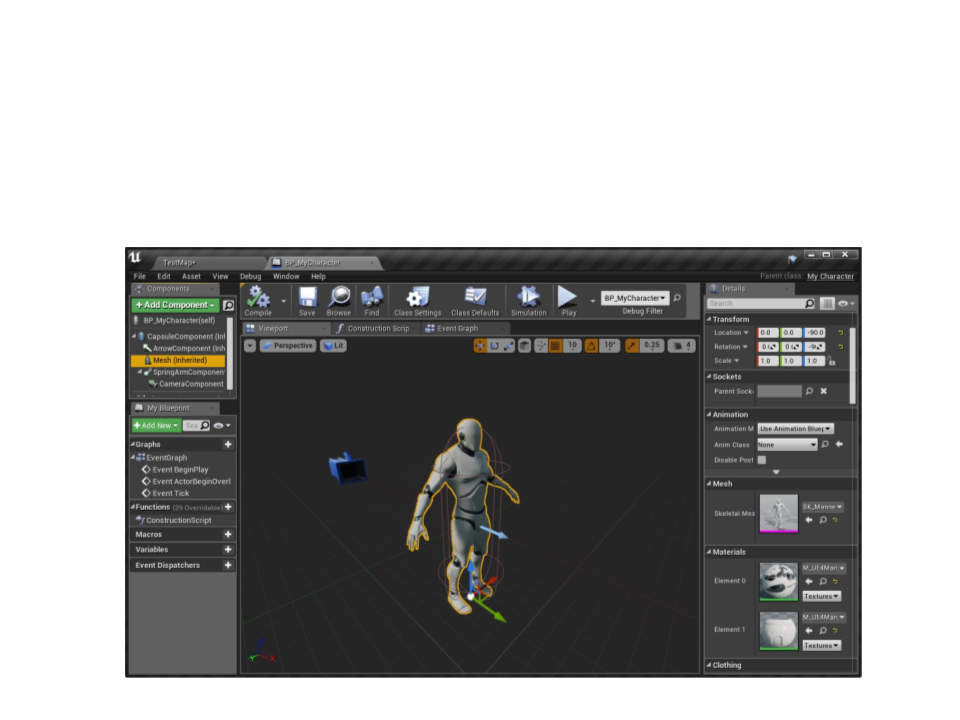
Multiplayer Game
•
Add and setup the model mesh in the character blueprint:

Multiplayer Game
•
Clear the animation blueprint (UE4ASP_HeroTPP_AnimBlueprint)
and setup the animation in the character blueprint.

Multiplayer Game
•
Implement the crouch action:
protected:
...
MyCharacter.h
void BeginCrouch();
void EndCrouch();
void AMyCharacter::BeginCrouch(){
Crouch();
}
MyCharacter.cpp
void AMyCharacter::EndCrouch(){
UnCrouch();
}
AMyCharacter::AMyCharacter(){
...
GetMovementComponent()->GetNavAgentPropertiesRef().bCanCrouch = true;
}
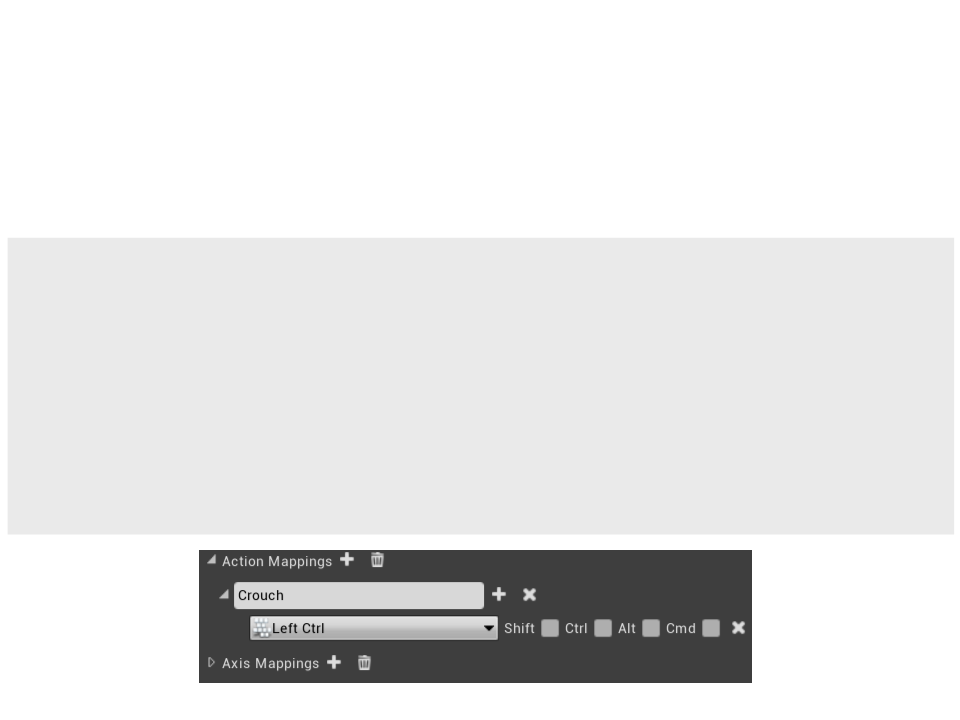
Multiplayer Game
•
Implement the crouch action:
MyCharacter.cpp
void AMyCharacter::SetupPlayerInputComponent(UInputComponent*
PlayerInputComponent){
...
PlayerInputComponent->BindAction("Crouch", IE_Pressed, this,
AMyCharacter::BeginCrouch);
PlayerInputComponent->BindAction("Crouch", IE_Released, this,
AMyCharacter::EndCrouch);
&
&
}

Multiplayer Game
•
Set the crouch variable in the animation blueprint:
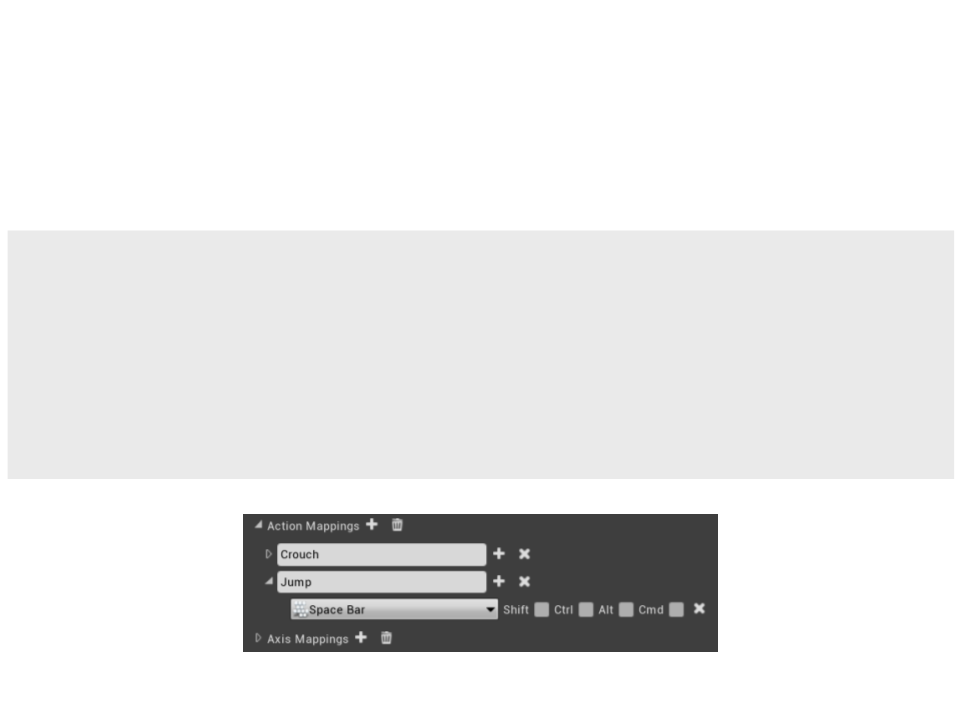
Multiplayer Game
•
Implement the jump action:
MyCharacter.cpp
void AMyCharacter::SetupPlayerInputComponent(UInputComponent*
PlayerInputComponent){
...
PlayerInputComponent->BindAction("Jump", IE_Pressed, this,
&AMyCharacter::Jump);
}
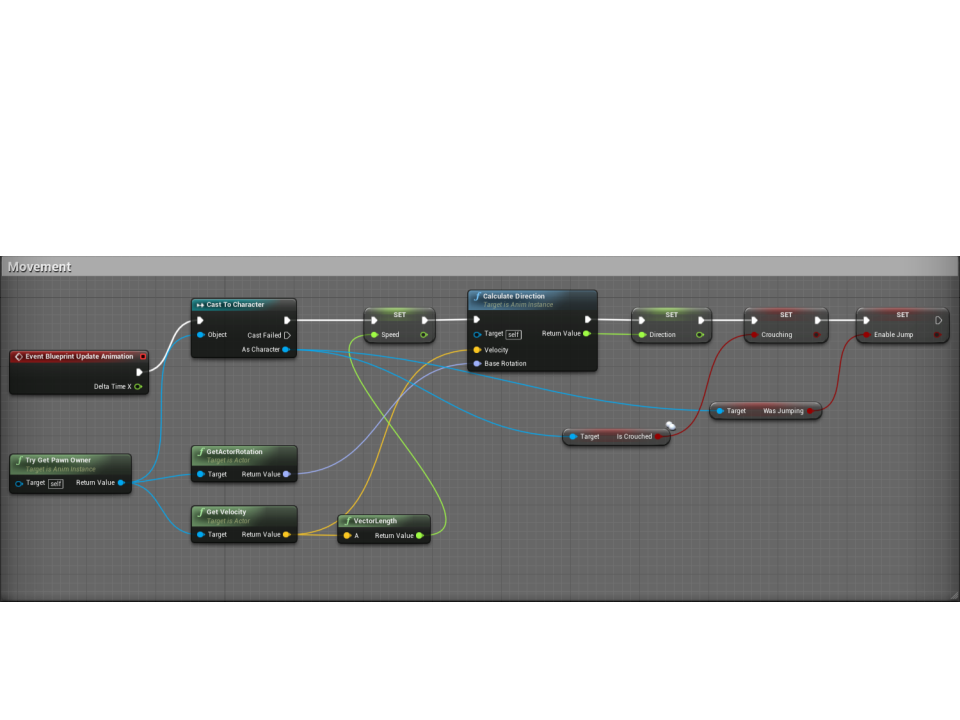
Multiplayer Game
•
Implement the jump action:
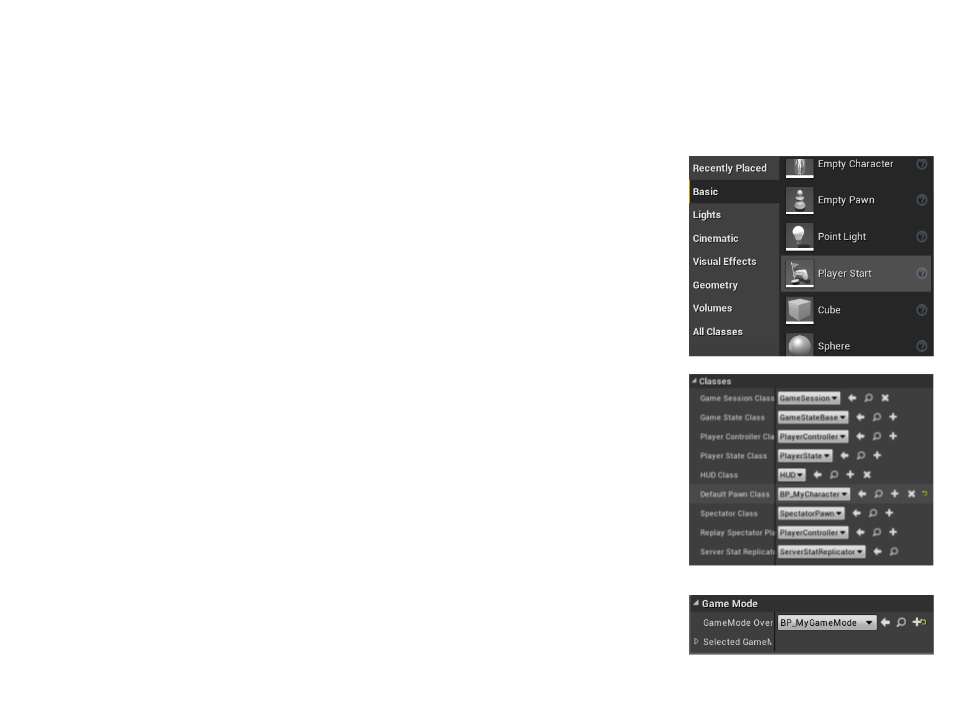
Multiplayer Game
•
Setup the game to be played in multiplayer:
1
. Delete the character from the map and add two
or more “Player Start” actors to the map.
2
. Create a new Game Mode blueprint and set our
character blueprint as default pawn class.
3
. Set the new Game Mode as the Game Mode for
the map in the World Settings.
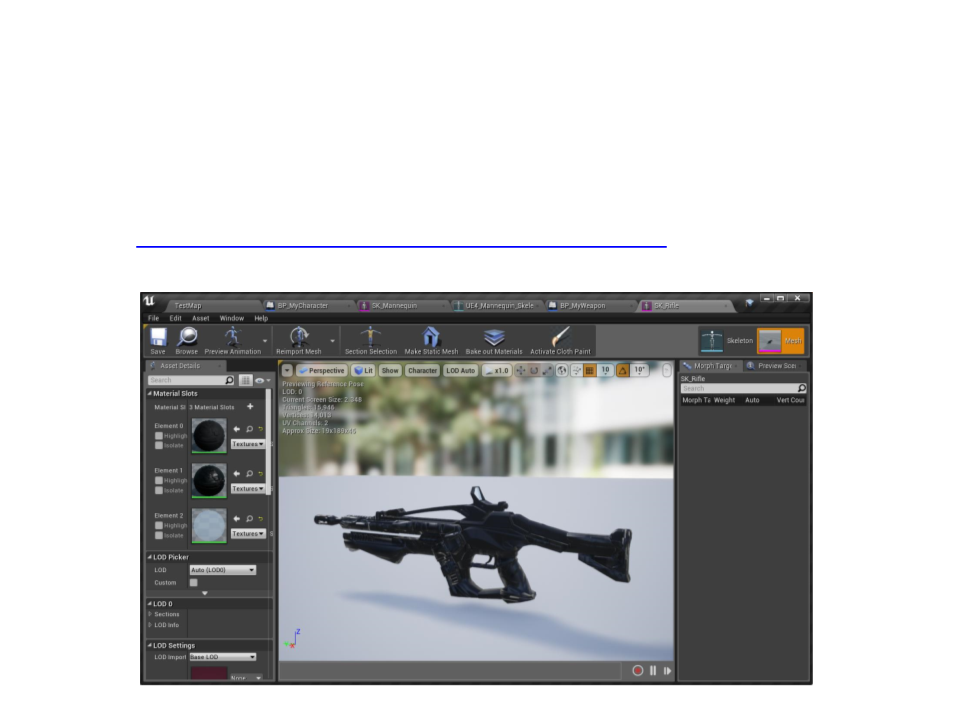
Multiplayer Game
•
Add a weapon: import the weapon mesh
–
http://www.inf.puc-rio.br/~elima/dp/weapon.zip
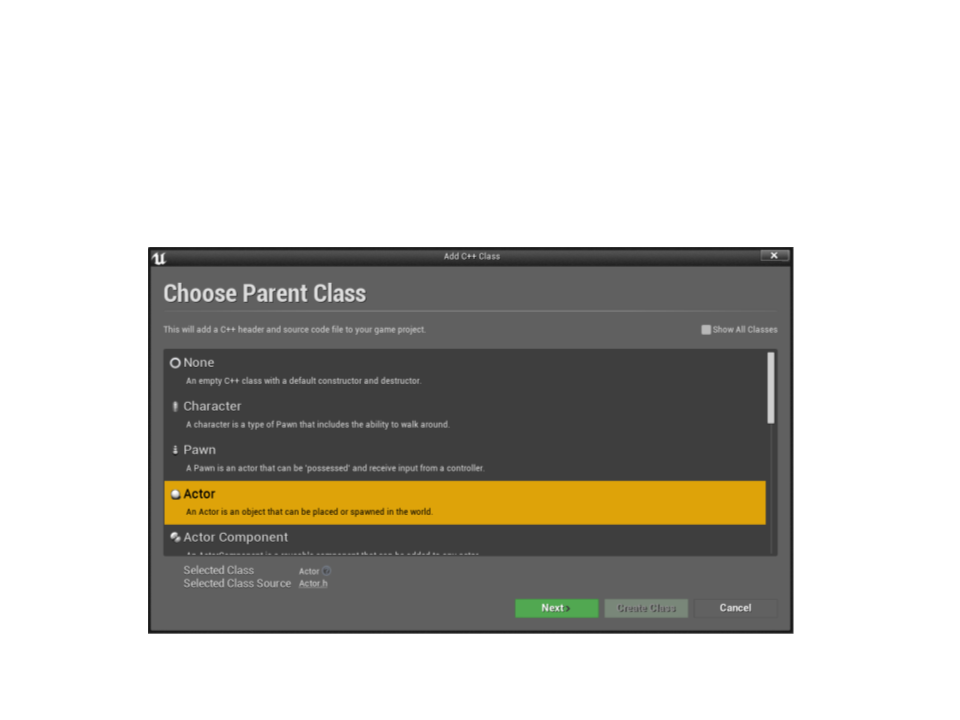
Multiplayer Game
•
Create a C++ class for the weapon:

Multiplayer Game
•
Implement the weapon:
protected:
MyWeapon.h
UPROPERTY(VisibleAnywhere, BlueprintReadOnly, Category = "Components")
class USkeletalMeshComponent* MeshComponent;
AMyWeapon::AMyWeapon()
{
MyWeapon.cpp
PrimaryActorTick.bCanEverTick = true;
MeshComponent = CreateDefaultSubobject<USkeletalMeshComponent>
("Mesh Component");
RootComponent = MeshComponent;
}
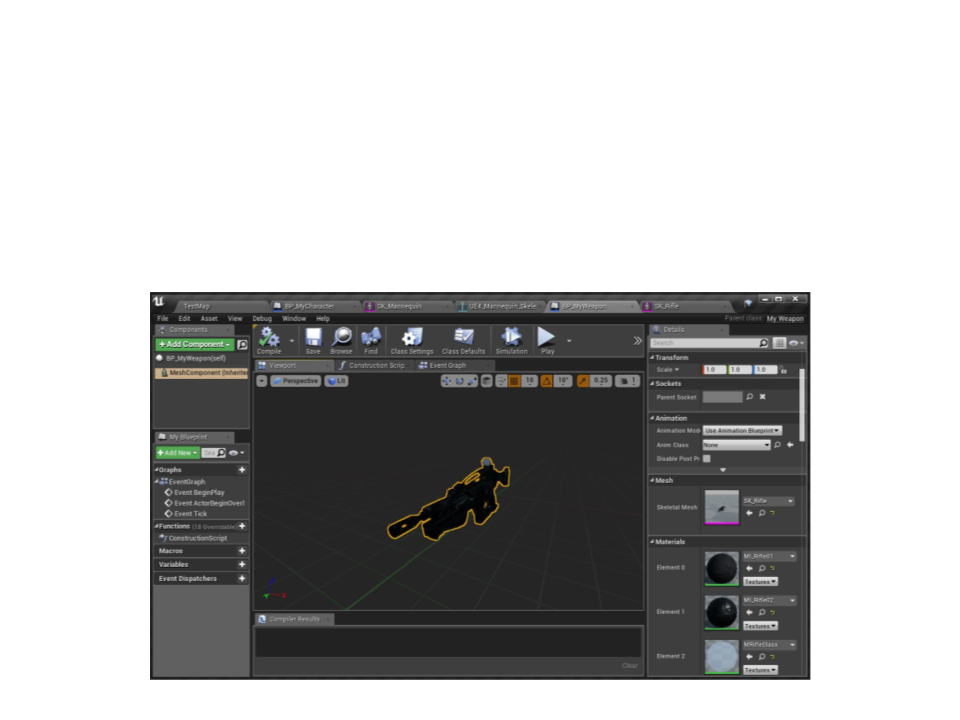
Multiplayer Game
•
Create a blueprint for the weapon class and select the
weapon mesh:
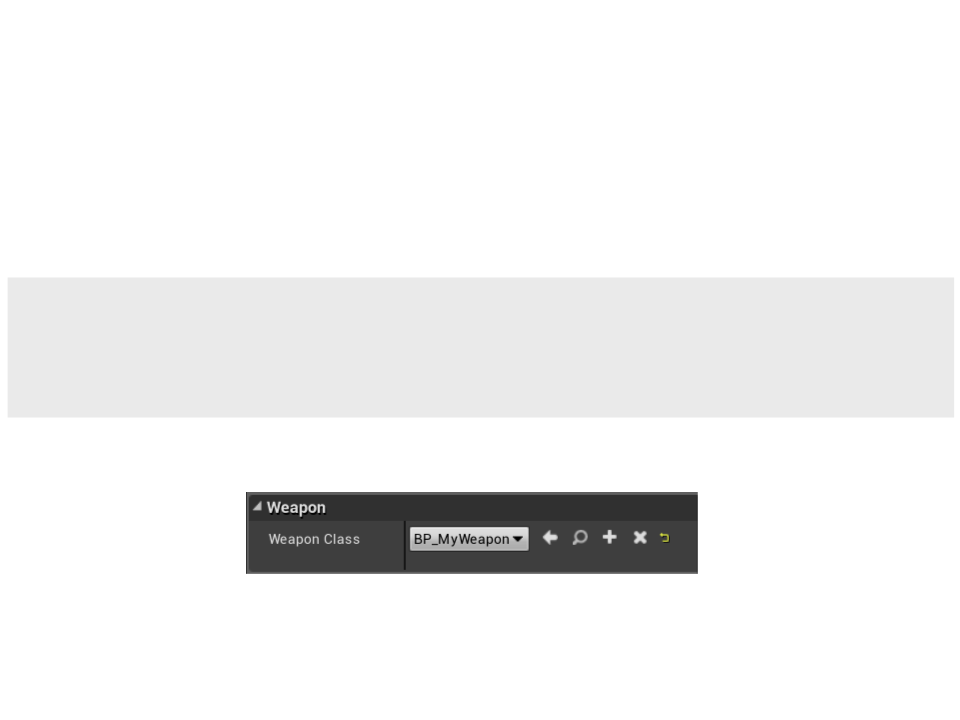
Multiplayer Game
•
Spawn the weapon and attach it to the character hand in the
BeginPlay event of the character blueprint:
protected:
class AMyWeapon* CurrentWeapon;
MyCharacter.h
UPROPERTY(EditDefaultsOnly, Category = "Weapon")
TSubclassOf<AMyWeapon> WeaponClass;

Multiplayer Game
•
Spawn the weapon and attach it to the character hand in the
BeginPlay event of the character blueprint:
void AMyCharacter::BeginPlay(){
Super::BeginPlay();
MyCharacter.cpp
if (WeaponClass){
FActorSpawnParameters parameters;
parameters.SpawnCollisionHandlingOverride =
ESpawnActorCollisionHandlingMethod::AlwaysSpawn;
CurrentWeapon = GetWorld()->SpawnActor<AMyWeapon>(WeaponClass,
FVector::ZeroVector, FRotator::ZeroRotator,
parameters);
if (CurrentWeapon){
CurrentWeapon->AttachToComponent(GetMesh(),
FAttachmentTransformRules::SnapToTargetNotIncludingScale,
"WeaponSocket");
CurrentWeapon->SetOwner(this);
}
}
}
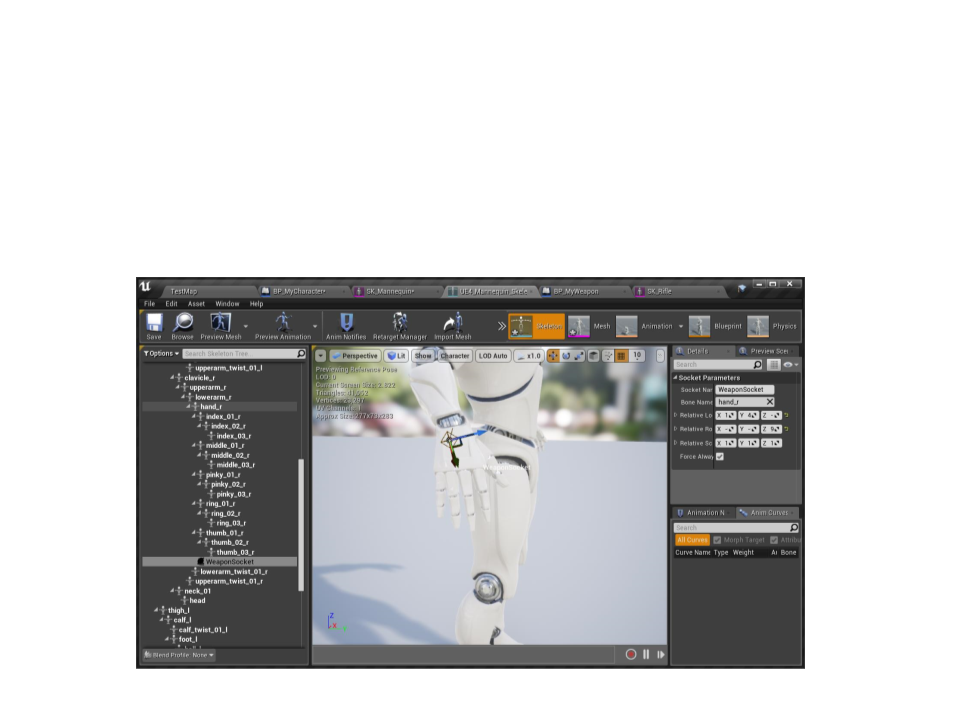
Multiplayer Game
•
Create a socket (“WeaponSocket”) in the skeleton of the
model to correctly attach the weapon to the character’s hand:

Multiplayer Game
•
Add the weapon as a “Preview Asset” into the socket and
adjust its position to the character’s hand:

Multiplayer Game
•
Implement the code to shoot with the weapon:
protected:
MyWeapon.h
...
UPROPERTY(EditDefaultsOnly, BlueprintReadOnly, Category = "Weapon")
TSubclassOf<UDamageType> DamageType;
.
..
public:
..
void Fire();
.

Multiplayer Game
•
Implement the code to shoot with the weapon:
void AMyWeapon::Fire()
{
MyWeapon.cpp
AActor* weaponOwner = GetOwner();
if (weaponOwner)
{
FVector eyeLocation;
FRotator eyeRotation;
weaponOwner->GetActorEyesViewPoint(eyeLocation, eyeRotation);
FVector endPoint = eyeLocation + (eyeRotation.Vector() * 1000);
FCollisionQueryParams cparams;
cparams.AddIgnoredActor(weaponOwner);
cparams.AddIgnoredActor(this);
cparams.bTraceComplex = true;
...

Multiplayer Game
•
Implement the code to shoot with the weapon:
...
MyWeapon.cpp
FHitResult hit;
if (GetWorld()->LineTraceSingleByChannel(hit, eyeLocation, endPoint,
ECC_Visibility, cparams)){
AActor* hitActor = hit.GetActor();
UGameplayStatics::ApplyPointDamage(hitActor, 10.0f,
eyeRotation.Vector(), hit,
weaponOwner->GetInstigatorController(),
this, DamageType);
}
DrawDebugLine(GetWorld(), eyeLocation, endPoint, FColor::Red,
false, 1.0f, 0, 1);
}
}

Multiplayer Game
•
Implement the code to shoot with the weapon:
protected:
..
void Fire();
..
public:
..
virtual FVector GetPawnViewLocation() const override;
MyCharacter.h
.
.
.

Multiplayer Game
•
Implement the code to shoot with the weapon:
void AMyCharacter::Fire()
{
MyCharacter.cpp
if (CurrentWeapon)
{
CurrentWeapon->Fire();
}
}
void AMyCharacter::SetupPlayerInputComponent(UInputComponent*
PlayerInputComponent){
...
PlayerInputComponent->BindAction("Fire", IE_Pressed, this,
&AMyCharacter::Fire);
}

Multiplayer Game
•
Implement the code to shoot with the weapon:
FVector AMyCharacter::GetPawnViewLocation() const
{
MyCharacter.cpp
if (CameraComponent)
{
return CameraComponent->GetComponentLocation();
}
return Super::GetPawnViewLocation();
}
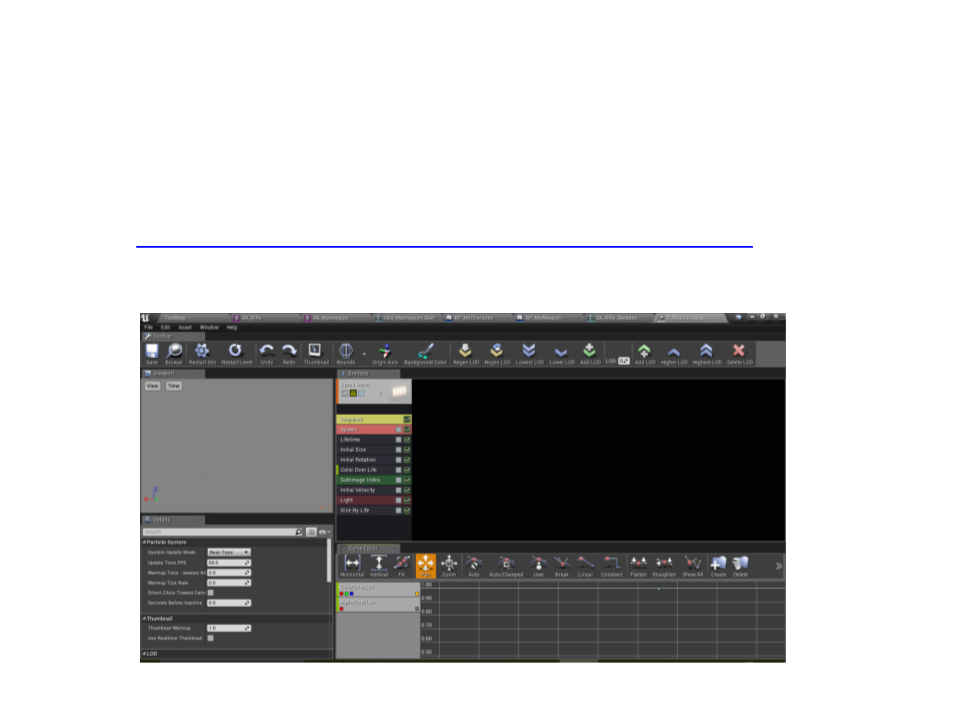
Multiplayer Game
•
Add particle effects to the weapon: import the particle effects
–
http://www.inf.puc-rio.br/~elima/dp/weapon_effects.zip

Multiplayer Game
•
Implement the code spawn the particle systems:
protected:
MyWeapon.h
...
UPROPERTY(EditDefaultsOnly, BlueprintReadOnly, Category = "Weapon")
UParticleSystem* FireEffect;
UPROPERTY(EditDefaultsOnly, BlueprintReadOnly, Category = "Weapon")
UParticleSystem* ImpactEffect;
UPROPERTY(EditDefaultsOnly, BlueprintReadOnly, Category = "Weapon")
UParticleSystem* TraceEffect;
void PlayFireEffects(FVector endPoint);
void PlayImpactEffects(FVector impactPoint);
...

Multiplayer Game
•
Implement the code spawn the particle systems:
void AMyWeapon::PlayFireEffects(FVector endPoint)
{
MyWeapon.cpp
if (FireEffect)
{
UGameplayStatics::SpawnEmitterAttached(FireEffect, MeshComponent,
"MuzzleFlashSocket");
}
if (TraceEffect)
{
UParticleSystemComponent* instTrace =
UGameplayStatics::SpawnEmitterAtLocation(GetWorld(), TraceEffect,
MeshComponent->GetSocketLocation("MuzzleFlashSocket"));
instTrace->SetVectorParameter("Target", endPoint);
}
}

Multiplayer Game
•
Implement the code spawn the particle systems:
void AMyWeapon::Fire(){
..
FHitResult hit;
MyWeapon.cpp
.
if (GetWorld()->LineTraceSingleByChannel(hit, eyeLocation, endPoint,
ECC_Visibility, cparams)){
...
PlayImpactEffects(hit.ImpactPoint);
endPoint = hit.ImpactPoint;
}
PlayFireEffects(endPoint);
}

Multiplayer Game
•
Setup the weapon effects:
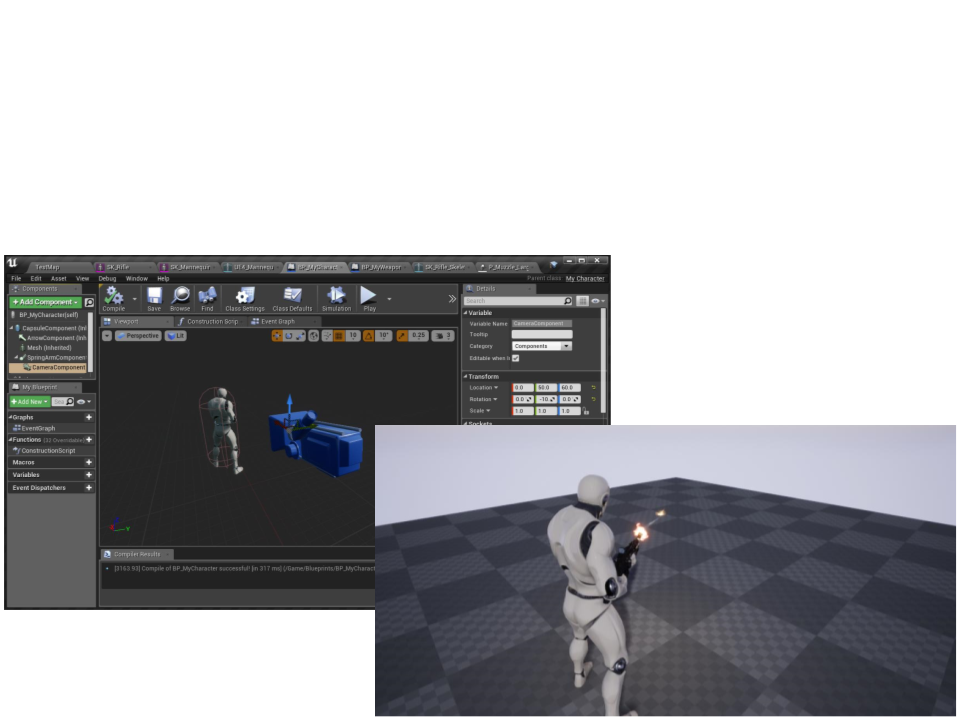
Multiplayer Game
•
Adjust the camera position and rotation in the character
blueprint for a better view:

Multiplayer Game
•
Add a crosshair to the center of the screen: create a widget
blueprint with a crosshair image at the center.

Multiplayer Game
•
Add a crosshair to the center of the screen: instantiate the
widget in the BeginPlay event of the character.

Multiplayer Game
•
Setup the weapons for multiplayer: only the server should
create the weapons, but currently the weapons are being
created in the BeginPlay event, which also runs on clients.
void AMyCharacter::BeginPlay(){
Super::BeginPlay();
MyCharacter.cpp
if ((Role == ROLE_Authority)&&(WeaponClass)){
FActorSpawnParameters parameters;
parameters.SpawnCollisionHandlingOverride =
ESpawnActorCollisionHandlingMethod::AlwaysSpawn;
CurrentWeapon = GetWorld()->SpawnActor<AMyWeapon>(WeaponClass,
FVector::ZeroVector, FRotator::ZeroRotator, parameters);
if (CurrentWeapon){
CurrentWeapon->AttachToComponent(GetMesh(),
FAttachmentTransformRules::SnapToTargetNotIncludingScale,
"WeaponSocket");
CurrentWeapon->SetOwner(this);
}
}
}
Multiplayer Game
•
Setup the weapons for multiplayer:
AMyWeapon::AMyWeapon()
{
MyWeapon.cpp
MyCharacter.h
...
SetReplicates(true);
}
protected:
..
.
UPROPERTY(Replicated)
class AMyWeapon* CurrentWeapon;
...

Multiplayer Game
•
Setup the weapons for multiplayer:
#include "Net/UnrealNetwork.h"
MyCharacter.cpp
...
void AEnemyCharacter::GetLifetimeReplicatedProps(
TArray<FLifetimeProperty>& OutLifetimeProps) const
{
Super::GetLifetimeReplicatedProps(OutLifetimeProps);
DOREPLIFETIME(AEnemyCharacter, isChasing);
}

Multiplayer Game
•
When a client fires the weapon, the Fire function must be
called on the client and on the server:
proteceted:
UFUNCTION(Server, Reliable, WithValidation)
void ServerFire();
MyWeapon.h
void AMyWeapon::ServerFire_Implementation()
{
MyWeapon.cpp
Fire();
}
bool AMyWeapon::ServerFire_Validate()
{
return true;
}

Multiplayer Game
•
When a client fires the weapon, the Fire function must be
called on the client and on the server:
void AMyWeapon::Fire()
{
MyWeapon.cpp
if (Role != ROLE_Authority)
{
ServerFire();
}
...

Multiplayer Game
•
The server must replicate the hit points to all clients (except
to the one that fired):
protected:
MyWeapon.h
...
UPROPERTY(ReplicatedUsing=OnReplicateHitPoint)
FVector_NetQuantize HitPoint;
UFUNCTION()
void OnReplicateHitPoint();
...

Multiplayer Game
•
The server must replicate the hit points to all clients (except
to the one that fired):
MyWeapon.cpp
void AMyWeapon::GetLifetimeReplicatedProps(TArray<FLifetimeProperty>&
OutLifetimeProps) const {
Super::GetLifetimeReplicatedProps(OutLifetimeProps);
DOREPLIFETIME_CONDITION(AMyWeapon, HitPoint, COND_SkipOwner);
}
void AMyWeapon::OnReplicateHitPoint()
{
PlayFireEffects(HitPoint);
PlayImpactEffects(HitPoint);
}

Multiplayer Game
•
The server must replicate the hit points to all clients (except
to the one that fired):
void AMyWeapon::Fire(){
if (Role != ROLE_Authority){
ServerFire();
MyWeapon.cpp
}
AActor* weaponOwner = GetOwner();
if (weaponOwner){
FVector eyeLocation;
FRotator eyeRotation;
weaponOwner->GetActorEyesViewPoint(eyeLocation, eyeRotation);
FVector endPoint = eyeLocation + (eyeRotation.Vector() * 1000);
FCollisionQueryParams cparams;
cparams.AddIgnoredActor(weaponOwner);
cparams.AddIgnoredActor(this);
cparams.bTraceComplex = true;
...

Multiplayer Game
•
The server must replicate the hit points to all clients (except
to the one that fired):
.
FHitResult hit;
..
MyWeapon.cpp
if (GetWorld()->LineTraceSingleByChannel(hit, eyeLocation, endPoint,
ECC_Visibility, cparams)){
AActor* hitActor = hit.GetActor();
UGameplayStatics::ApplyPointDamage(hitActor, 10.0f, eyeRotation.
Vector(), hit, weaponOwner->GetInstigatorController(),
this, DamageType);
PlayImpactEffects(hit.ImpactPoint);
endPoint = hit.ImpactPoint;
}
PlayFireEffects(endPoint);
if (Role == ROLE_Authority){
HitPoint = endPoint;
}
}
}
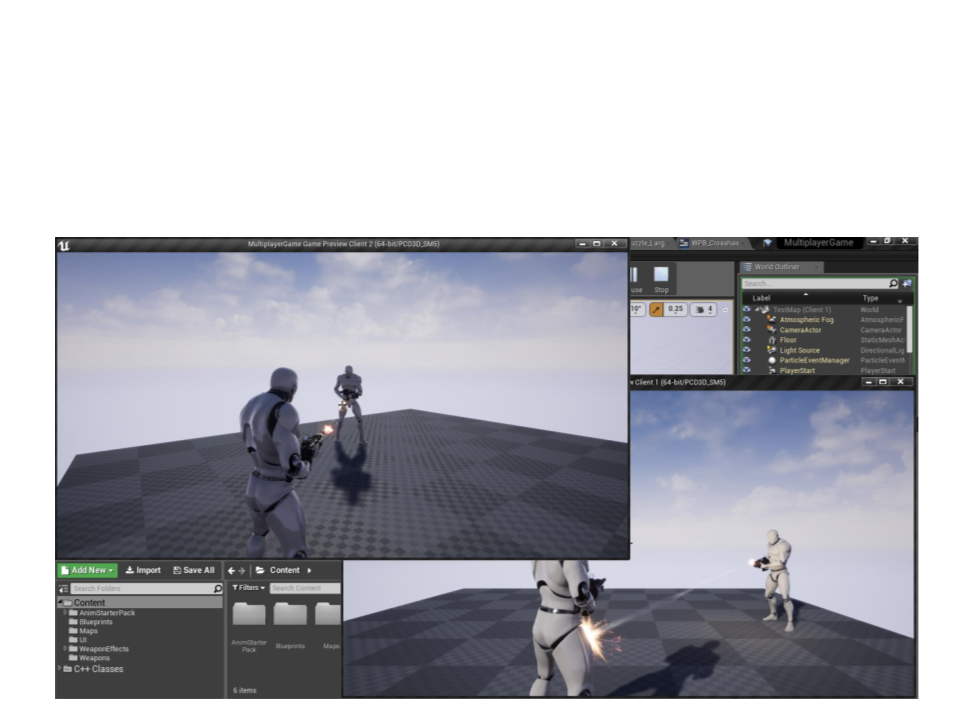
Multiplayer Game
•
Test the game:
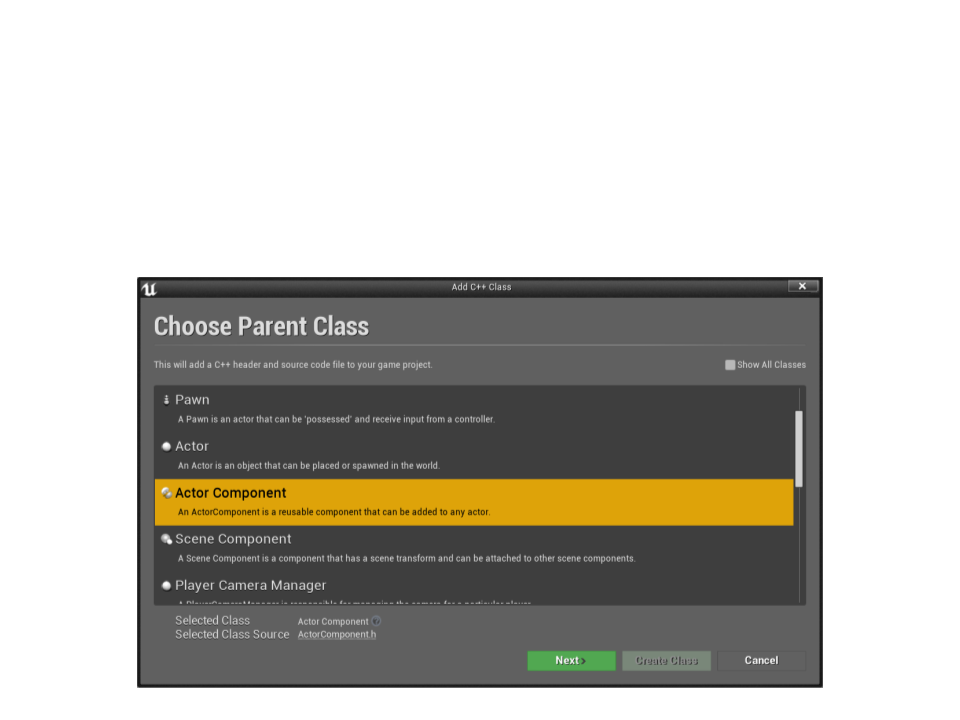
Multiplayer Game
•
Create a new Component class (C++) to implement the Health
Component:

Multiplayer Game
•
Implement the Health Component:
MyHealthComponent.h
DECLARE_DYNAMIC_MULTICAST_DELEGATE_SixParams(FOnHealthChangedSignature,
UMyHealthComponent*, HealthComponent, float, health, float,
damage, const class UDamageType*, DamageType, class
AController*, InstigatedBy, AActor*, DamageCauser);
...
protected:
UPROPERTY(EditDefaultsOnly, BlueprintReadOnly, Category = "Health")
float Health;
UFUNCTION()
void OnTakeDamage(AActor* DamagedActor, float Damage, const class
UDamageType* DamageType, class AController* InstigatedBy,
AActor* DamageCauser);
.
..
public:
UPROPERTY(BlueprintAssignable, Category = "Events")
FOnHealthChangedSignature OnHealthChangedEvent;

Multiplayer Game
•
Implement the Health Component:
UMyHealthComponent::UMyHealthComponent(){
Health = 100;
MyHealthComponent.cpp
}
void UMyHealthComponent::BeginPlay(){
Super::BeginPlay();
AActor* myOwner = GetOwner();
if (myOwner){
myOwner->OnTakeAnyDamage.AddDynamic(this,
&UMyHealthComponent::OnTakeDamage);
}
}
void UMyHealthComponent::OnTakeDamage(AActor* DamagedActor, float
Damage, const class UDamageType* DamageType, class
AController* InstigatedBy, AActor* DamageCauser){
Health = Health - Damage;
if (Health < 0)
Health = 0;
OnHealthChangedEvent.Broadcast(this, Health, Damage, DamageType,
InstigatedBy, DamageCauser);
}

Multiplayer Game
•
Add the Health Component to the character:
...
MyCharacter.h
protected:
UPROPERTY(EditDefaultsOnly, BlueprintReadOnly, Category = "Player")
bool IsDead;
UPROPERTY(VisibleAnywhere, BlueprintReadOnly, Category = "Components")
class UMyHealthComponent * HealthComponent;
...
UFUNCTION()
void OnHealthChanged(class UMyHealthComponent* healthComp,
float health, float damage, const class UDamageType*
DamageType, class AController* InstigatedBy, AActor*
DamageCauser);
...

Multiplayer Game
•
Add the Health Component to the character:
AMyCharacter::AMyCharacter()
{
MyCharacter.cpp
...
HealthComponent = CreateDefaultSubobject<UMyHealthComponent>
("Health Component");
HealthComponent->OnHealthChangedEvent.AddDynamic(this,
&AMyCharacter::OnHealthChanged);
...
}
void AMyCharacter::BeginPlay()
{
Super::BeginPlay();
IsDead = false;
...
}

Multiplayer Game
•
Add the Health Component to the character:
MyCharacter.cpp
void AMyCharacter::OnHealthChanged(UMyHealthComponent* HealthComponent,
float health, float damage, const class UDamageType*
DamageType, class AController* InstigatedBy, AActor*
DamageCauser){
if ((health <= 0)&&(!IsDead))
{
IsDead = true;
GetMovementComponent()->StopMovementImmediately();
GetCapsuleComponent()->SetCollisionEnabled(ECollisionEnabled::
NoCollision);
}
}
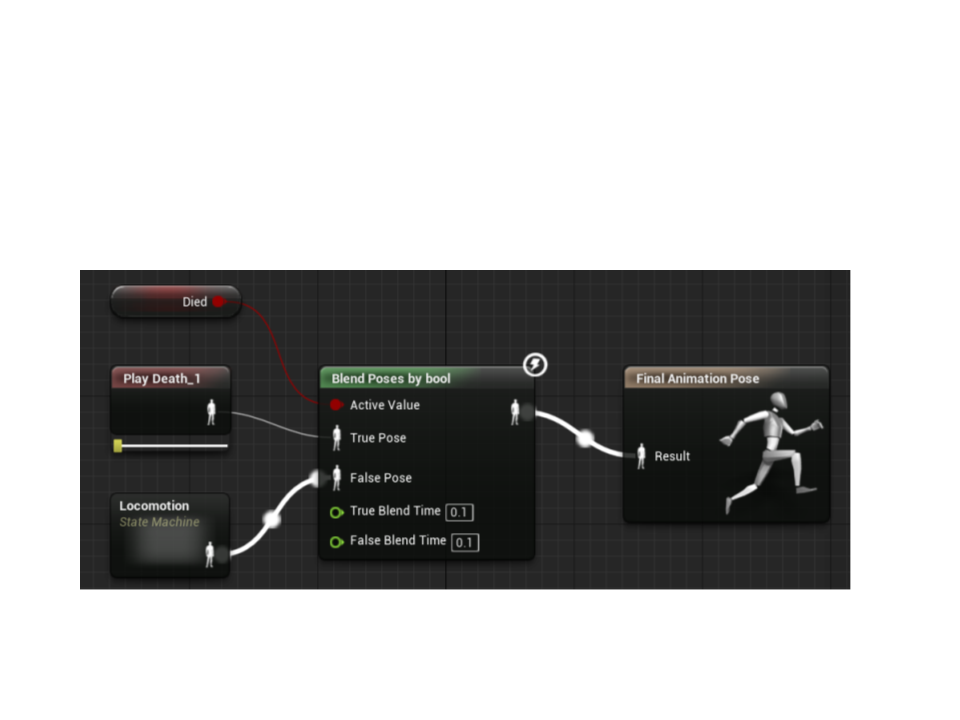
Multiplayer Game
•
Implement the death animation logic:

Multiplayer Game
•
Implement the death animation logic:
Multiplayer Game
•
Replicate the health over the network:
MyHealthComponent.h
protected:
UPROPERTY(Replicated, EditDefaultsOnly, BlueprintReadOnly,
Category = "Health")
float Health;
MyHealthComponent.cpp
UMyHealthComponent::UMyHealthComponent(){
..
SetIsReplicated(true);
.
}
void UMyHealthComponent::BeginPlay(){
Super::BeginPlay();
if (GetOwnerRole() == ROLE_Authority) {
AActor* myOwner = GetOwner();
if (myOwner){
myOwner->OnTakeAnyDamage.AddDynamic(this,
&UMyHealthComponent::OnTakeDamage);
}
}
}

Multiplayer Game
•
Replicate the health over the network:
MyHealthComponent.cpp
void UMyHealthComponent::GetLifetimeReplicatedProps(Tarray
<FLifetimeProperty>& OutLifetimeProps) const
{
}
Super::GetLifetimeReplicatedProps(OutLifetimeProps);
DOREPLIFETIME(UMyHealthComponent, Health);

Multiplayer Game
•
Replicate the death animation over the network:
MyCharacter.h
protected:
UPROPERTY(Replicated, BlueprintReadOnly, Category = "Player")
bool IsDead;
MyCharacter.cpp
void AMyCharacter::GetLifetimeReplicatedProps(TArray<FLifetimeProperty>&
OutLifetimeProps) const {
Super::GetLifetimeReplicatedProps(OutLifetimeProps);
DOREPLIFETIME(AMyCharacter, CurrentWeapon);
DOREPLIFETIME(AMyCharacter, IsDead);
}
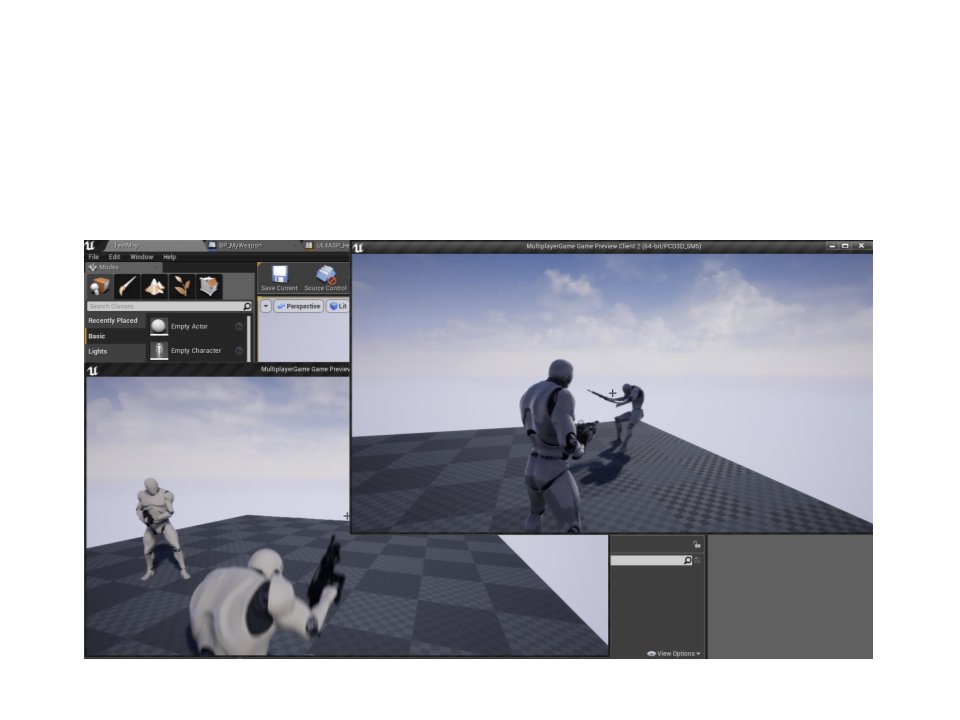
Multiplayer Game
•
Test the results:
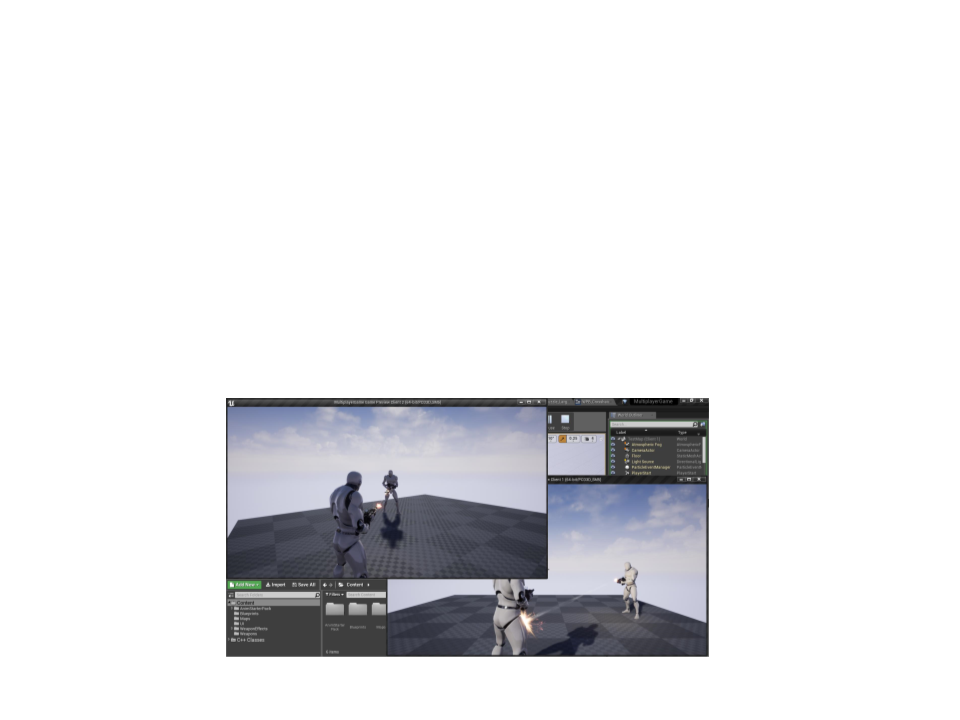
Exercise 1
1
) Continue the development of the multiplayer game and add
the following features:
–
–
–
Display the player health on the HUD;
When the player is killed, display a “game over” message;
When all other players are killed, display a “you win” message;

Further Reading
•
•
Carnall, B. (2016). Unreal Engine 4.X By Example. Packt
Publishing. ISBN: 978-1785885532.
Web Resources:
–
Networking and Multiplayer in Unreal Engine -
https://docs.unrealengine.com/en-us/Gameplay/Networking
–
Network Guide -
https://wiki.unrealengine.com/index.php?title=4_13%2B_Network_
Guide
